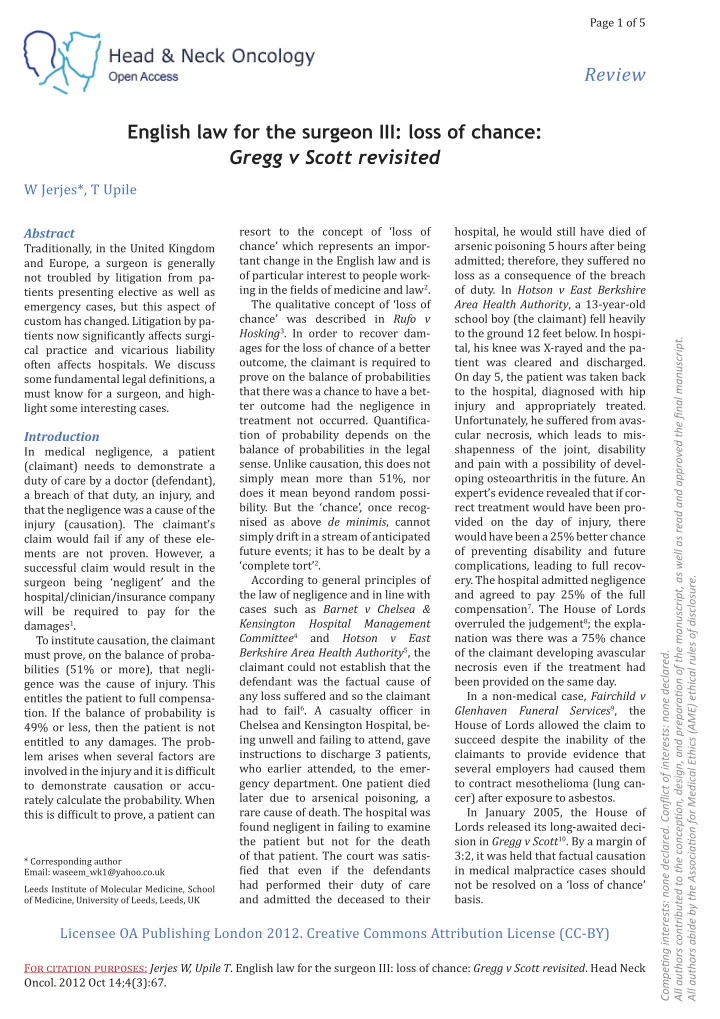

Page 1 of 5 Review English law for the surgeon III: loss of chance: Gregg v Scott revisited W Jerjes*, T Upile resort to the concept of ‘loss of hospital, he would still have died of Abstract chance’ which represents an impor- arsenic poisoning 5 hours after being Traditionally, in the United Kingdom tant change in the English law and is admitted; therefore, they suffered no and Europe, a surgeon is generally of particular interest to people work- loss as a consequence of the breach not troubled by litigation from pa- ing in the fields of medicine and law 2 . of duty. In Hotson v East Berkshire tients presenting elective as well as The qualitative concept of ‘loss of Area Health Authority , a 13-year-old emergency cases, but this aspect of chance’ was described in Rufo v school boy (the claimant) fell heavily custom has changed. Litigation by pa- Hosking 3 . In order to recover dam- to the ground 12 feet below. In hospi- tients now significantly affects surgi- All authors contributed to the conceptjon, design, and preparatjon of the manuscript, as well as read and approved the fjnal manuscript. ages for the loss of chance of a better tal, his knee was X-rayed and the pa- cal practice and vicarious liability outcome, the claimant is required to tient was cleared and discharged. often affects hospitals. We discuss prove on the balance of probabilities On day 5, the patient was taken back some fundamental legal definitions, a that there was a chance to have a bet- to the hospital, diagnosed with hip must know for a surgeon, and high- ter outcome had the negligence in injury and appropriately treated. light some interesting cases. treatment not occurred. Quantifica- Unfortu nately, he suffered from avas- tion of probability depends on the cular necrosis, which leads to mis- Introduction balance of probabilities in the legal shapenness of the joint, disability In medical negligence, a patient sense. Unlike causation, this does not and pain with a possibility of devel- (claimant) needs to demonstrate a simply mean more than 51%, nor oping osteoarthritis in the future. An duty of care by a doctor (defendant), does it mean beyond random possi- expert’s evidence revealed that if cor- a breach of that duty, an injury, and bility. But the ‘chance’, once recog- rect treatment would have been pro- that the negligence was a cause of the nised as above de minimis , cannot vided on the day of injury, there injury (causation). The claimant’s simply drift in a stream of anticipated would have been a 25% better chance claim would fail if any of these ele- future events; it has to be dealt by a of preventing disability and future ments are not proven. However, a ‘complete tort’ 2 . complications, leading to full recov- successful claim would result in the According to general principles of ery. The hospital admitted negligence All authors abide by the Associatjon for Medical Ethics (AME) ethical rules of disclosure. surgeon being ‘negligent’ and the the law of negligence and in line with and agreed to pay 25% of the full hospital/clinician/insurance company cases such as Barnet v Chelsea & compensation 7 . The House of Lords will be required to pay for the Kensington Hospital Management overruled the judgement 8 ; the expla- damages 1 . Committee 4 and Hotson v East nation was there was a 75% chance To institute causation, the claimant Berkshire Area Health Authority 5 , the of the claimant developing avascular must prove, on the balance of proba- Competjng interests: none declared. Confmict of interests: none declared. claimant could not establish that the necrosis even if the treatment had bilities (51% or more), that negli- defendant was the factual cause of been provided on the same day. gence was the cause of injury. This any loss suffered and so the claimant In a non-medical case, Fairchild v entitles the patient to full compensa- had to fail 6 . A casualty officer in Glenhaven Funeral Services 9 , the tion. If the balance of probability is Chelsea and Kensington Hospital, be- House of Lords allowed the claim to 49% or less, then the patient is not ing unwell and failing to attend, gave succeed despite the inability of the entitled to any damages. The prob- instructions to discharge 3 patients, claimants to provide evidence that lem arises when several factors are who earlier attended, to the emer- several employers had caused them involved in the injury and it is difficult gency department. One patient died to contract mesothelioma (lung can- to demonstrate causation or accu- later due to arsenical poisoning, a cer) after exposure to asbestos. rately calculate the probability. When rare cause of death. The hospital was In January 2005, the House of this is difficult to prove, a patient can found negligent in failing to examine Lords released its long-awaited deci- the patient but not for the death sion in Gregg v Scott 10 . By a margin of of that patient. The court was satis- 3:2, it was held that factual causation * Corresponding author fied that even if the defendants in medical malpractice cases should Email: waseem_wk1@yahoo.co.uk had performed their duty of care not be resolved on a ‘loss of chance’ Leeds Institute of Molecular Medicine, School and admitted the deceased to their basis. of Medicine, University of Leeds, Leeds, UK Licensee OA Publishing London 2012. Creative Commons Attribution License (CC-BY) For citation purposes: Jerjes W, Upile T . English law for the surgeon III: loss of chance: Gregg v Scott revisited . Head Neck Oncol. 2012 Oct 14;4(3):67.
Recommend
More recommend